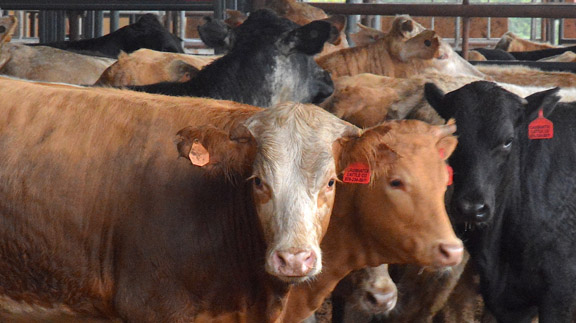Farm & Ranch
[AgriLife Today] Cattle market pressured by heavier weights, fewer heifer placements

Dr. David Anderson, Texas A&M AgriLife Extension Service livestock economist in College Station, said the recent cattle on feed report released by the U.S. Department of Agriculture depicts fewer heifers placed on feed, signaling continued expansion among producers across the country. (Texas A&M AgriLife Extension Service photo by Blair Fannin)
By: Blair Fannin
Writer: Blair Fannin, 979-845-2259, [email protected]
Contact: Dr. David Anderson, 979-845-4351, [email protected]
COLLEGE STATION – More feedlot placements than expected, coupled with large supplies of cold storage beef, will pressure cattle prices in the near term, according to a Texas A&M AgriLife Extension Service livestock economist.
Dr. David Anderson, livestock economist in College Station, said the recent cattle on feed report released by the U.S. Department of Agriculture depicts fewer heifers placed on feed, signaling continued expansion among producers across the country.
“The report has indicated the running themes we have had throughout 2015, which has been fewer placements and a trend in placing heavier animals,” he said. “This is being driven by fewer cows and calves in 2014 and continued in 2015. There were heavy financial losses by cattle feeder operators in 2015. They paid premiums for those animals and then the market dropped lower, forcing them to hold onto to those feeders and add more gain to compensate for the premium they paid.”
The USDA report indicated placements were slightly lower, about one percent less than the year before, Anderson said.
“More cattle were placed weighing over 700 and 800 pounds while total placements declined,” Anderson said. “The report indicated fewer placed, but heavier. The result of the cattle on feed report was half a percent lower than the year before. I think as the market digests this there will be bearish talk in terms of the futures market because placements are bigger than expected and marketings are lower than expected.”
Anderson said the report also included a quarterly breakdown of heifers on feed.
“This report historically goes back to 1996,” he said. “We found in the latest report this was the fewest number of heifers on feed Jan. 1 than in the past 20 years. This gives you more evidence of the strength of expansion going on. We’ve got more steers on feed than a year ago and a record low number of heifers on feed.”
Anderson pointed to another report, the beef cold storage report, that indicated a record supply of beef on hand.
“Throughout 2015, we built up a record supply of cold storage of beef,” he said. “In December, we put more beef in cold storage, more than we did in November. This points out there is a heck of a lot of beef in cold storage. In this case, it’s due to record imports of beef that we brought in, because of record high prices, strength of the dollar and drought in Australia. When it comes here it has to stay somewhere cold, so it stays in the cold chain.
“Going forward, most cold-storage beef is boneless beef that is made into ground beef. That’s a large supply we’ve got to work off going through 2016. As beef imports back off during the year, it will help bring those storage amounts down.”
To view Anderson’s video comments, see http://bit.ly/1RJbGny .
-30-
LikeTweet
Find more stories, photos, videos and audio at http://today.agrilife.org
Farm & Ranch
Hazards of Backyard Poultry

By Barry Whitworth, DVM
Having backyard poultry is a popular agriculture enterprise. According to the United States Department of Agriculture, 0.8 percent of all households in the United States have chickens. People keep chickens for a variety of reasons with table eggs being one of the more common reasons.
Unfortunately, some of these poultry producers are not aware of the hazards that come with keeping poultry because many times they carry pathogens but appear healthy.
Chickens are carriers of several zoonotic diseases. These are diseases that can be passed from animals to humans. According to a recent survey in Pennsylvania, a majority of backyard poultry producers were aware of the dangers of avian influenza. However, this study also revealed that far fewer producers were aware of the risk of possible exposure to Salmonella and Campylobacter.
The lack of knowledge about the hazards of raising poultry likely contributes to the continued issues of Salmonella outbreaks associated with backyard poultry. In 2023, the Centers for Disease Control and Prevention reported 1,072 illnesses of Salmonella linked to backyard poultry, and 272 of those patients required hospitalization. Oklahoma reported 43 individuals with the disease.
To read more, pick up a copy of the April issue of NTFR magazine. To subscribe by mail, call 940-872-5922.
Farm & Ranch
Ag Elsewhere: Wyoming

By Tressa Lawrence
Babies are tucked away in every nook and cranny. Many ranchers across Wyoming have baby animals popping up all over this time of year.
Farm & Ranch
Ag Elsewhere: Montana

By Lindsey Monk
Another load of grain in to keep feeding the calves until the green grass can really start popping.
-

 Country Lifestyles1 year ago
Country Lifestyles1 year agoScott & Stacey Schumacher: A Growth Mindset
-

 Equine7 months ago
Equine7 months agoThe Will to Win
-

 Country Lifestyles7 years ago
Country Lifestyles7 years agoStyle Your Profile – What your style cowboy hat says about you and new trends in 2017
-

 Country Lifestyles4 years ago
Country Lifestyles4 years agoAmber Crawford, Breakaway Roper
-

 HOME7 years ago
HOME7 years agoGrazing North Texas – Wilman Lovegrass
-

 Country Lifestyles7 years ago
Country Lifestyles7 years agoDecember 2016 Profile, Rusty Riddle – The Riddle Way
-

 Country Lifestyles8 years ago
Country Lifestyles8 years agoJune 2016 Profile – The man behind the mic: Bob Tallman
-

 Outdoor9 years ago
Outdoor9 years agoButtercup or Primrose?






